化学品生态毒性测试鱼类模式生物的应用与展望
2017-06-27沈敏KatherineCoady董晶JohnDavis胡璟柴运宙高仁君
沈敏,Katherine Coady, 董晶,John Davis,胡璟,柴运宙,高仁君
1. 陶氏化学(中国)投资有限公司,上海 2012032. 陶氏化学公司,美国 米德兰 486743. 陶氏化学(中国)投资有限公司,北京 100738
化学品生态毒性测试鱼类模式生物的应用与展望
沈敏1,Katherine Coady2, 董晶1,John Davis2,胡璟2,柴运宙2,高仁君3,
1. 陶氏化学(中国)投资有限公司,上海 2012032. 陶氏化学公司,美国 米德兰 486743. 陶氏化学(中国)投资有限公司,北京 100738
水生生物毒性测试广泛应用于评估化学品的水生态环境安全,而鱼类生态毒性数据为水生生态风险评估与风险管理提供基础。本文总结了现有的鱼类水生毒性测试标准及常用的物种。阐述了常用水生鱼类模式生物,如斑马鱼Danio rerio、青鳉鱼Oryzias latipes、黑头软口鲦Pimephales promelas等作为模式鱼类的特征及在生态毒性测试中的应用。环保部7号令推荐稀有鮈鲫Gobiocypris rarus作为中国本土生物在水生毒性测试中使用。目前公开发表的利用稀有鮈鲫的水生毒性研究多集中在急性毒性方面,对其他类型的研究如法规毒理相关的长期慢性毒性有待开展。
模式鱼类;稀有鮈鲫;斑马鱼;青鳉鱼;黑头软口鲦;生态毒理测试
对选定的生物物种进行科学研究,用于解释某种具有普遍规律生命现象的物种称为模式生物[1]。模式生物的选择需主要符合以下几点:(1)生理特征能够代表生物界的某一大类群;(2)容易获得并易于在实验室内饲养和繁殖;(3)世代短、子代多、遗传背景清楚;(4)容易进行试验操作。常见的模式生物有大肠杆菌Escherichia coli、酵母Saccharomyces cerevisiae、线虫Saccharomyces cerevisiae、果蝇Saccharomyces cerevisiae、小鼠Mus musculus、斑马鱼Danio rerio、非洲爪蟾Xenopus laevis等。其中斑马鱼和非洲爪蟾为水生模式动物可用于评估环境及健康安全。斑马鱼可用于毒理学、发育生物学、毒理病理学、基因通路等研究,非洲爪蟾用于细胞生物学、毒理学、神经学、发育生物学的研究。
水生毒性测试主要用于评估化学品的水生生态环境安全,使用何种水生生物进行毒性测试、如何选择代表性物种、及物种的数据如何外推到其他物种是需要考虑的关键问题。水生毒性测试结果可用于支持GHS(全球化学品统一分类和标签制度)分类、PNEC(预测无效应浓度)推导及PBT(持久性、生物蓄积性和毒性)等的评估。急性毒性测试通常作为起始的试验项目,比如藻类生长抑制试验、溞类急性活动抑制试验及鱼类急性毒性试验。慢性试验可以对低浓度化学物质长期的影响进行预测,比如大型溞繁殖试验及各种鱼类慢性毒性试验。
1 生态毒性测试中的鱼类模式动物 (Model Fish for Ecotoxicity Test)
鱼类作为脊椎动物是生态毒理学测试常见的试验材料。Di Giulio和Hinton[2]列举了测试鱼种的选择标准:(1)普遍可用及有足够背景信息的鱼类;(2)敏感度和行为历史已知;(3)首先考虑土著和有代表性的鱼类,(4)容易进行实验室培育和养护。为提高生态风险评估可靠性,获得有代表性鱼类的毒性数据非常必要。鱼类生态毒性数据是水生生态风险评估与风险管理的基础。鱼类急性毒性试验主要测试化学品对鱼类短期内的毒性效应(96 h半致死浓度)。鱼类胚胎急性毒性测试化学品对鱼类胚胎的短期毒性效应,是鱼类急性毒性测试潜在的替代试验。鱼类慢性毒性试验测试化学物质对鱼类不同生命阶段或整个生命周期的致死和亚致死效应,亚致死效应包括对生长发育繁殖的毒性效应等。表1总结了生态毒理鱼类毒性测试方法及相关的测试标准[3-28]。
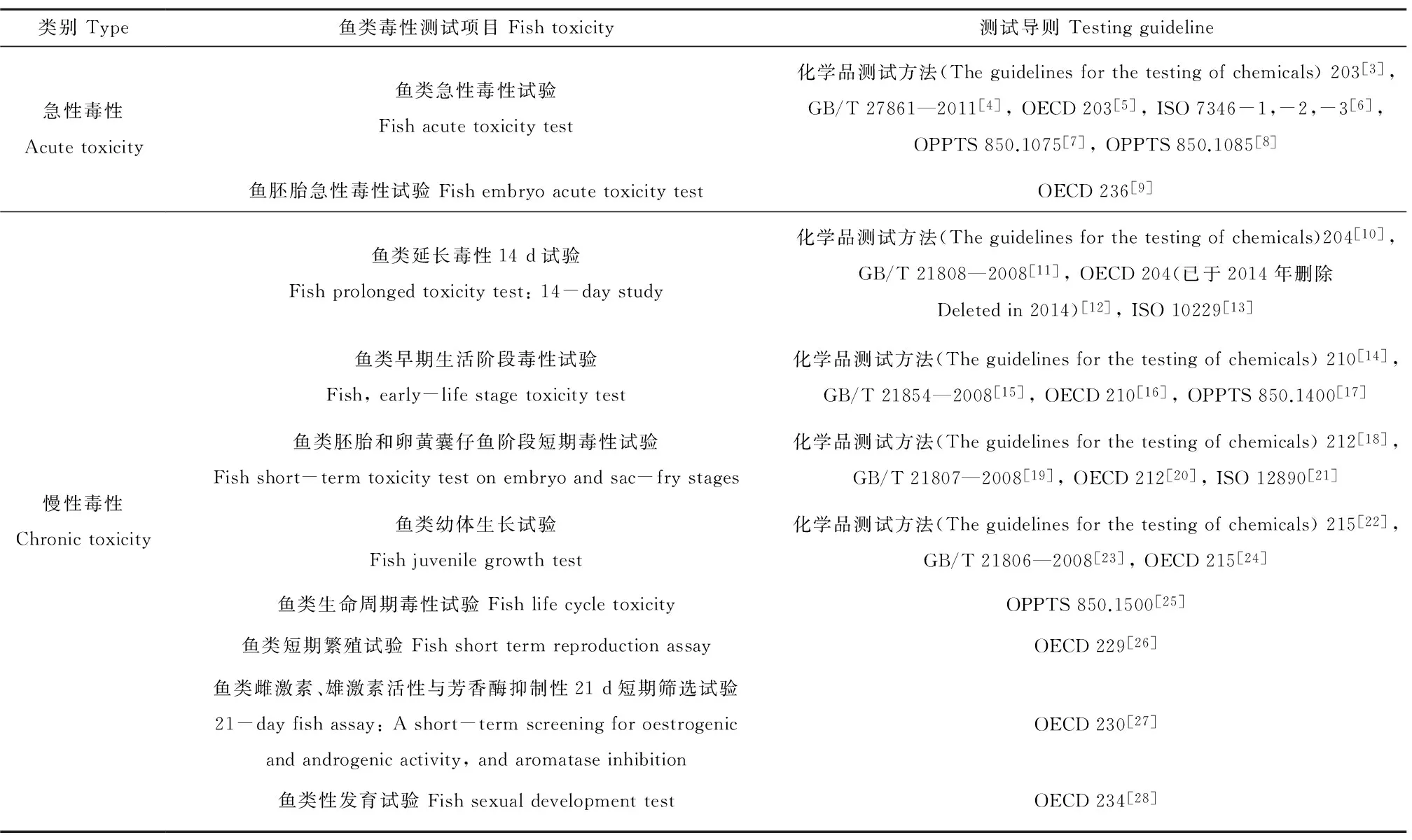
表1 鱼类生态毒性测试方法Table 1 Ecotoxicity testing guideline of fish toxicity
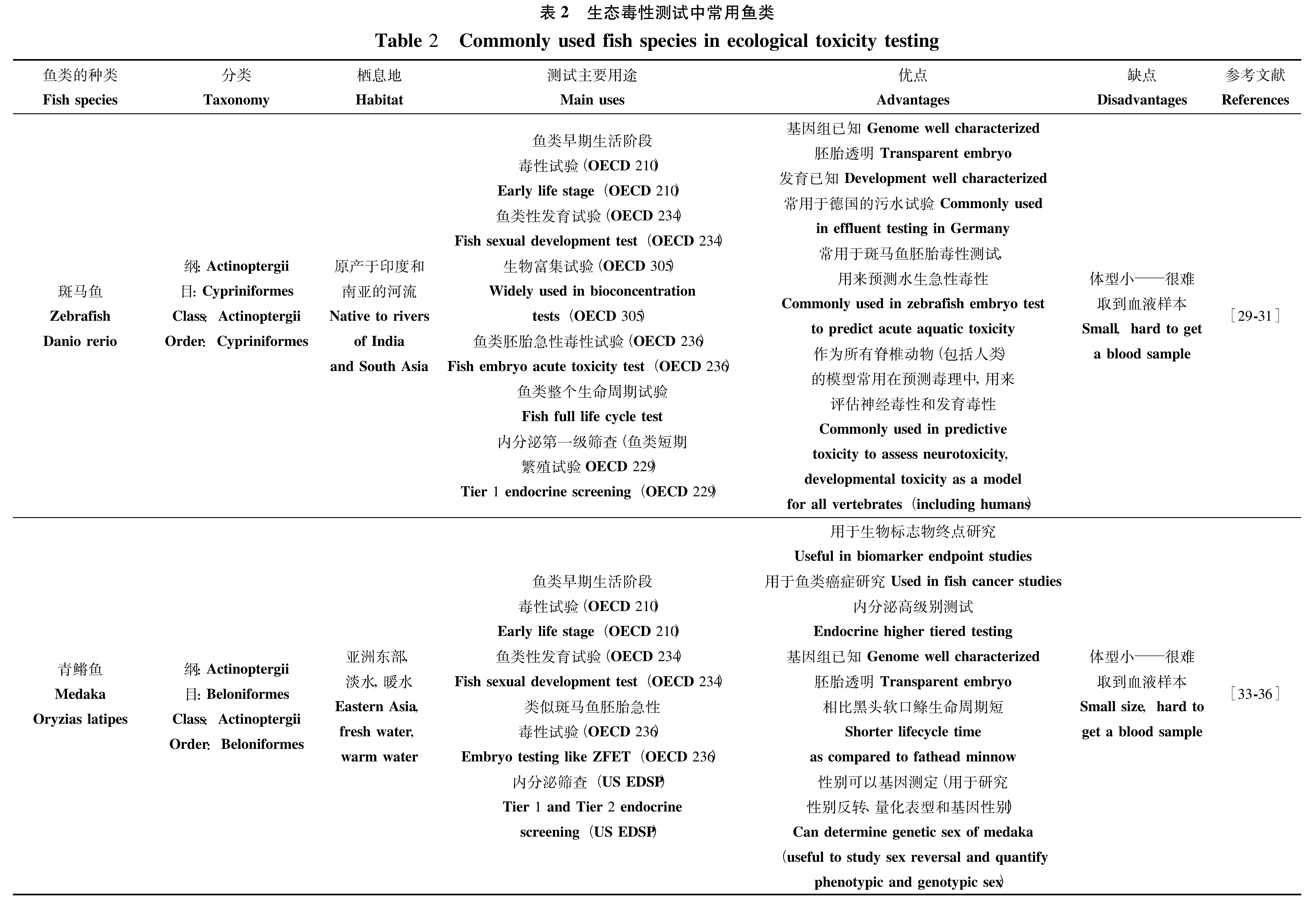
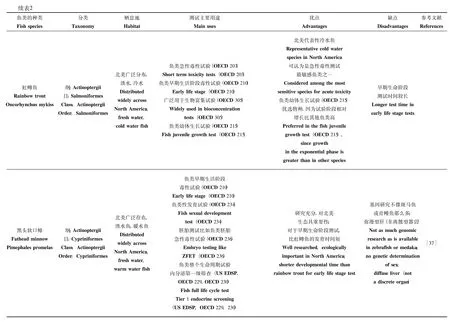
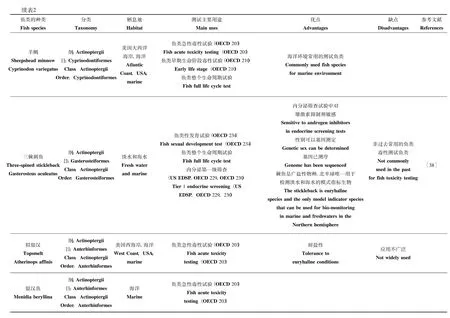
2 生态毒性测试常用模式鱼类比较 (Comparison of commonly used fish species in environmental toxicity testing)
目前国际上常用的生态毒性测试鱼类包括斑马鱼、青鳉鱼、黑头软口鲦等。表2总结了生态毒性测试中常用的鱼类,包括分类、栖息地、测试主要用途、优缺点等。这些测试鱼种有足够的背景,敏感度、行为历史已知,容易实验室培育和养护。在代表性方面,斑马鱼为国际常用物种,黑头软口鲦为北美常用鱼种,而青鳉鱼在东亚常用。
2.1 斑马鱼
斑马鱼Danio rerio起源于印度,为小型的热带鱼类,繁殖快,便于养殖。斑马鱼的基因组及发育都已被很好的表征。作为所有脊椎动物(包括人类)的模型,斑马鱼作为模式生物的使用正逐渐拓展和深入到生命体的多种系统(例如神经系统、免疫系统、心血管系统、生殖系统等)的发育、功能和疾病研究中[29-30],并已应用于小分子化合物的大规模新药筛选[31]。斑马鱼产卵周期短,产卵量大,并且可以很容易控制产卵时间,且胚胎在体外发育,早期胚胎完全透明,易于观察内部结构,常用斑马鱼胚胎毒性测试来预测水生急性毒性。斑马鱼常用于生态毒理学测试,如急性毒性试验、慢性毒性试验(包括整个生命周期及内分泌筛查测试)。斑马鱼及其转基因品种在环境监测方面也有应用,如用于调查水污染状况或用于特定污染物的检测等[32]。
2.2 青鳉鱼
青鳉鱼Oryzias latipes是起源于亚洲的淡水鱼,主要见于日本、韩国和中国东部。其生理学、胚胎学和遗传学被广泛研究[33-34]。青鳉鱼的胚胎、仔鱼和幼鱼透明,可用于研究生长发育情况[35]。青鳉鱼的基因组已被很好地表征[36]。青鳉鱼的性别可以基因测定,用于研究性别反转、量化表型和基因性别等。青鳉鱼常被用于生态急性毒性和慢性毒性及内分泌效应方面的研究。
2.3 黑头软口鲦
黑头软口鲦Pimephales promelas是水生毒理学领域常用的小型模式鱼类,广泛应用于法规测试和研究中,特别是在北美地区[37]。从48 h急性致死到部分或全生命周期测试,用黑头软口鲦进行的毒性测试经常用于法规监管项目中,比如高产量化学品(HPV)筛选评估,复杂混合物比如废水的影响,及内分泌干扰筛选项目。这个物种也被广泛用于各类研究中,重点的研究主题包括定量构效关系(QSAR)模型开发、混合物毒性、化合物效应跨物种外推,以及了解实验室结果与野外影响的相关性。黑头软口鲦的属性让它成为解决生态毒理学新挑战的很好的模型,比如对具有不同作用机制的化合物识别敏感的生命阶段或毒理学终点、基于生物组织数据预测种群水平的效应、探索了解基因组学在研究和法规中的应用等。
2.4 其他
其他鱼类如虹鳟Oncorhynchus mykiss、鲤鱼Cyprinus carpio、蓝鳃太阳鱼Lepomis macrochirus等也是常用淡水鱼类,用于测定水生生态毒性。除淡水鱼外,海水鱼包括羊鲷Cyprinodon variegatus、刺鱼Gasterosteus aculeatus、银汉鱼Menidia beryllina等是海洋环境常用的测试鱼类。
3 中国稀有鮈鲫的应用展望 (Chinese rare minnow application outlook)
根据环境保护部(MEP)2010年发布的7号令《新化学物质管理办法》,新化学物质申报需在中国境内使用中国的供试生物完成生态毒理学测试[39]。稀有鮈鲫(Gobiocypris rarus)作为中国本土生物在水生毒性测试中被推荐使用。自2010年7号令实施以来,稀有鮈鲫的生态毒理研究及测试报告数量大幅增加。但与国际通用鱼种相比,稀有鮈鲫尚未被列入OECD导则推荐鱼种中。从工业界的角度看,稀有鮈鲫毒性数据要被中国以外的国家广泛接受还需要继续深入研究和验证。而无论是稀有鮈鲫还是其他已存在的不同推荐鱼种,对化学物质毒性敏感性的潜在差异可能会导致不同国家或地区对水生环境危害的GHS分类不一致,这一点也需要各国化学品环境管理机构给予关注。
通过分析国际及国内发表的稀有鮈鲫研究发现,稀有鮈鲫应用于毒理学的研究呈现上升趋势,毒性终点涉及从基因到个体等不同水平的研究。目前稀有鮈鲫法规毒理相关的水生毒性研究多集中在急性毒性方面,但公开发表的法规毒理相关的慢性毒性数据非常有限。发表的文献对稀有鮈鲫急性毒性研究的化合物主要集中在重金属,如Cr、Hg、Cd等重金属及有机化合物,如杀虫剂、杀菌剂等的研究[40-46]。除内分泌干扰物外[47-48],对其他类型化合物的慢性毒性公开发表的文献比较有限。
通过对稀有鮈鲫不同生命阶段的毒性效应研究发现,不同生命周期的敏感性可能不同。毒死蜱对稀有鮈鲫不同生命阶段的毒性如下:96 h-LC50胚胎7.59 mg·L-1、仔鱼0.395 mg·L-1、幼鱼0.0478 mg·L-1和成鱼0.0272 mg·L-1[40],说明稀有鮈鲫对毒死蜱的敏感性随着其发育而增强。而镉对胚胎72 h-EC50为0.219 mg·L-1[41]、仔鱼96 h-LC50为2.59 mg·L-1[42]、成鱼96 h-LC50为12.2 mg·L-1[43],说明稀有鮈鲫的胚胎对镉更加敏感。
表3总结了不同化合物对5种鱼类包含稀有鮈鲫和国际通用鱼种,如斑马鱼、青鳉和虹鳟鱼等的急性毒性数据(96 h-LC50)。对比分析化学品对稀有鮈鲫及国际通用鱼类毒性发现:稀有鮈鲫对5种杀菌剂的敏感性各不相同[44]; 对于重金属铬和对氯苯胺,斑马鱼、稀有鮈鲫和虹鳟鱼的急性毒性相似[45-46];对于杀虫剂毒死蜱,稀有鮈鲫的敏感性高于斑马鱼[40]。
吴本丽(2014)等[43]用胚胎-卵黄囊吸收阶段毒性试验方法(OECD 212)分析了稀有鮈鲫对氯化镉和对氯苯胺的长期毒性。对于环保部《新化学物质申报登记指南》中推荐的另外2种慢性毒性测定方法,鱼类早期生活阶毒性试验(OECD 210)及鱼类幼体生长试验(OECD 215)目前未见有关稀有鮈鲫的公开发表数据。表4比较了2种不同的化合物对不同鱼类的慢性毒性。
通过分析国际及国内发表的稀有鮈鲫研究发现,目前其水生毒性的研究多集中在急性毒性方面,对其法规毒理慢性毒性研究有待继续开展。运用稀有鮈鲫已有毒性数据验证定量构效关系(QSAR)模型或改进预测模型,可以作为风险评估的筛选手段。对比稀有鮈鲫和国际通用鱼类对更多化学品的敏感性,开展稀有鮈鲫对更多化合物的国际及国内实验室急慢性试验验证,将会使稀有鮈鲫对化学品的安全性评价更具说服力,增加国际间认可,为水生GHS分类的一致性及动物福利做出重要贡献。

表3 化合物对不同鱼类的急性毒性(96 h-LC50)比较 (mg·L-1)Table 3 Comparison of acute toxicity (96 h-LC50) of different fish species (mg·L-1)
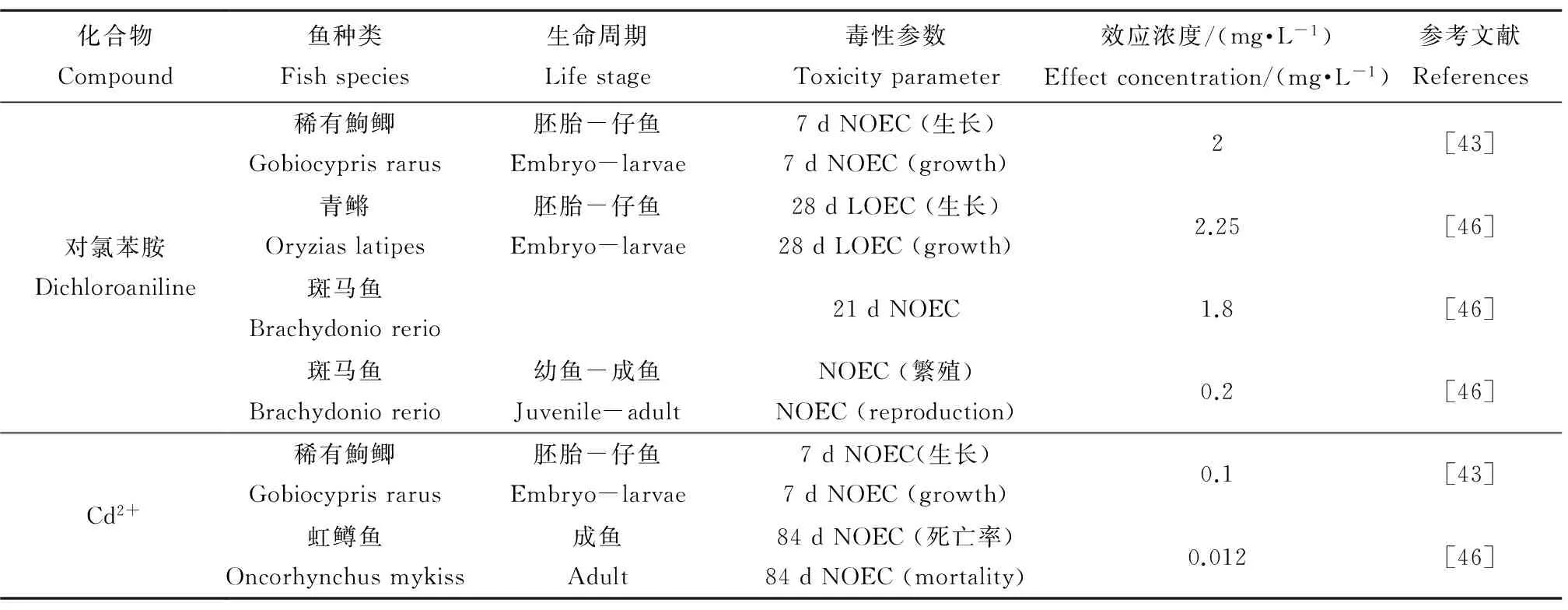
表4 化合物对不同鱼类的慢性毒性比较Table 4 Comparison of chronic toxicity of different fish species
[1] Fields S, Johnson M. Whither model organism research?[J]. Science, 2005, 307(5717): 1885-1886
[2] Di Giulio R T, Hinton D E. The Toxicology of Fishes [M]. CRC Press, 2008: 3-66
[3] 环境保护部化学品登记中心. 化学品测试方法生物系统效应卷,203鱼类急性毒性试验[S]. 北京:环境保护部化学品登记中心, 2013
MEP SCC. The guidelines for the testing of chemicals—Effects on biotic systems, 203 Fish acute toxicity test [S]. Beijing: MEP SCC, 2013 (in Chinese)
[4] 中华人民共和国质量监督检验检疫总局,中国国家标准化管理委员会. GB/T 27861—2011. 化学品鱼类急性毒性试验[S]. 北京:中华人民共和国质量监督检验检疫总局,中国国家标准化管理委员会, 2011
General Administration of Quality Supervision, Inspection and Quarantine of PRC, Standardization Administration of PRC. GB/T 27861-2011, Chemicals - Fish acute toxicity test [S]. Being: General Administration of Quality Supervision, Inspection and Quarantine of PRC, Standardization Administration of PRC, 2011 (in Chinese)
[5] OECD. Guidelines for Testing of Chemicals, 203: Fish, Acute Toxicity Test [S]. Paris: OECD, 1992
[6] ISO. ISO 7346-1, -2, -3, Water quality—Determination of the acute lethal toxicity of substances to a freshwater fish [Brachydanio rerio Hamilton-Buchanan (Teleostei, Cyprindidae)], part 1 static method; part 2 semi-static; part 3 flow-through method [S]. Geneva: ISO, 1996
[7] United States Environmental Protection Agency. Ecological Effects Test Guidelines, OPPTS 850.1075, Fish acute toxicity test, freshwater and marine [S]. Washington DC: US EPA, 1996
[8] United States Environmental Protection Agency. Ecological Effects Test Guidelines, OPPTS 850.1085, Fish acute toxicity mitigated by humic acid [S]. Washington DC: US EPA, 1996
[9] OECD. Guidelines for Testing of Chemicals, 236: Fish Embryo Acute Toxicity (FET) Test [S]. Paris: OECD, 2013
[10] 环境保护部化学品登记中心. 化学品测试方法生物系统效应卷,204鱼类14天延长毒性试验[S]. 北京:环境保护部化学品登记中心, 2013
MEP SCC. The guidelines for the testing of chemicals—Effects on biotic systems, 204 Fish prolonged toxicity: 14-day study test [S]. Beijing: MEP SCC, 2013 (in Chinese)
[11] 中华人民共和国质量监督检验检疫总局,中国国家标准化管理委员会. GB/T 21808—2008 化学品鱼类延长毒性14天试验[S]. 北京:中华人民共和国质量监督检验检疫总局,中国国家标准化管理委员会, 2008
General Administration of Quality Supervision, Inspection and Quarantine of PRC, Standardization Administration of PRC. GB/T 21808-2008 Chemicals- Fish prolonged toxicity: 14-day study test [S]. Beijing: General Administration of Quality Supervision, Inspection and Quarantine of PRC, Standardization Administration of PRC, 2008 (in Chinese)
[12] OECD. Guidelines for Testing of Chemicals, 204: Fish, Prolonged Toxicity Test: 14-Day Study [S]. Paris: OECD, 1984
[13] ISO. ISO 10229. Water quality—Determination of the prolonged toxicity of substances to freshwater fish — Method for evaluating the effects of substances on the growth rate of rainbow trout [Oncorhynchus mykiss Walbaum (Teleostei, Salmonidae)] [S]. Geneva: ISO, 1994
[14] 环境保护部化学品登记中心. 化学品测试方法生物系统效应卷,210鱼类早期生命阶段毒性试验[S]. 北京:环境保护部化学品登记中心,2013
MEP SCC. The guidelines for the testing of chemicals — Effects on biotic systems, 210 Fish early-life stage toxicity test [S]. Beijing: MEP SCC, 2013 (in Chinese)
[15] 中华人民共和国质量监督检验检疫总局,中国国家标准化管理委员会. GB/T 21854—2008 化学品鱼类早期生命阶段试验[S]. 北京:中华人民共和国质量监督检验检疫总局,中国国家标准化管理委员会, 2008
General Administration of Quality Supervision, Inspection and Quarantine of PRC, Standardization Administration of PRC. GB/T 21854-2008 Chemicals- Fish early-life stage toxicity test [S]. Beijing: General Administration of Quality Supervision, Inspection and Quarantine of PRC, Standardization Administration of PRC, 2008 (in Chinese)
[16] OECD. Guidelines for Testing of Chemicals, 210: Fish, Early-Life Stage Toxicity Test [S]. Paris: OECD, 1992
[17] United States Environmental Protection Agency. Ecological Effects Test Guidelines, OPPTS 850.1400, Fish early-life stage toxicity test [S]. Washington DC: US EPA, 1996
[18] 环境保护部化学品登记中心. 化学品测试方法生物系统效应卷,212鱼类胚胎-卵黄囊吸收阶段的短期毒性试验[S]. 北京:环境保护部化学品登记中心, 2013
MEP SCC. The guidelines for the testing of chemicals — Effects on biotic systems, 212 Fish short term toxicity test on embryo and sac-fry stages [S]. Beijing: MEP SCC, 2013 (in Chinese)
[19] 中华人民共和国质量监督检验检疫总局,中国国家标准化管理委员会. GB/T 21807—2008, 化学品鱼类胚胎和卵黄囊仔鱼阶段的短期毒性试验[S]. 北京:中华人民共和国质量监督检验检疫总局,中国国家标准化管理委员会, 2008
General Administration of Quality Supervision, Inspection and Quarantine of PRC, Standardization Administration of PRC. GB/T 21807-2008 Chemicals- Fish short term toxicity test on embryo and sac-fry [S]. Beijing: General Administration of Quality Supervision, Inspection and Quarantine of PRC, Standardization Administration of PRC, 2008 (in Chinese)
[20] OECD. Guidelines for Testing of Chemicals, 212: Fish, Short-term Toxicity Test on Embryo and Sac-Fry Stages [S]. Paris: OECD, 1998
[21] ISO. ISO 12890. Water quality - Determination of toxicity to embryos and larvae of freshwater fish -- semi-static method [S]. Geneva: ISO, 1999
[22] 环境保护部化学品登记中心. 化学品测试方法生物系统效应卷,215 鱼类幼体生长试验[S]. 北京:环境保护部化学品登记中心,2013
MEP SCC. The guidelines for the testing of chemicals — Effects on biotic systems, 215 Fish juvenile growth test [S]. Beijing: MEP SCC, 2013 (in Chinese)
[23] 中华人民共和国质量监督检验检疫总局,中国国家标准化管理委员会. GB/T 21806—2008 鱼类幼体生长试验[S]. 北京:中华人民共和国质量监督检验检疫总局,中国国家标准化管理委员会, 2008
General Administration of Quality Supervision, Inspection and Quarantine of PRC, Standardization Administration of PRC. GB/T 21806-2008 Chemicals - Fish juvenile growth test [S]. Beijing: General Administration of Quality Supervision, Inspection and Quarantine of PRC, Standardization Administration of PRC, 2008 (in Chinese)
[24] OECD. Guidelines for Testing of Chemicals, 215: Fish, Juvenile Growth Test [S]. Paris: OECD, 2000
[25] United States Environmental Protection Agency. Ecological Effects Test Guidelines, OPPTS 850.1500, Fish life cycle toxicity [S]. Washington DC: US EPA, 1996
[26] OECD. Guidelines for Testing of Chemicals, 229: Fish Short Term Reproduction Assay [S]. Paris: OECD, 2012
[27] OECD. Guidelines for Testing of Chemicals, 230: 21-day Fish Assay: A Short-Term Screening for Oestrogenic and Androgenic Activity, and Aromatase Inhibition [S]. Paris: OECD, 2009
[28] OECD. Guidelines for Testing of Chemicals, 234: Fish Sexual Development Test [S]. Paris: OECD, 2011
[29] Hill A J, Teraoka H, Heideman W, et al. Zebrafish as a model vertebrate for investigating chemical toxicity [J]. Toxicological Sciences, 2005, 86: 6-19
[30] Sipes N S, Padilla S, Knudsen T B. Zebrafish—As an integrative model for twenty-first century toxicity testing [J]. Birth Defects Research (Part C), 2011, 93: 256-257
[31] Chakraborty C, Hsu C H, Wen Z H, et al. Zebrafish: A complete animal model for in vivo drug discovery and development [J]. Current Drug Metabolism, 2009, 10: 116-124
[32] 刘在平,张松林. 斑马鱼在环境检测领域中的应用[J]. 环境监测与预警, 2011, 3(1): 17-20
Liu Z P, Zhang S L. Application of zebrafish in the field of environmental detection [J]. Environmental Monitoring and Forewarning, 2011, 3(1): 17-20 (in Chinese)
[33] Wittbrodt J, Shima A, Schartl M. Medaka—A model organism from the far east [J]. Nature Reviews Genetics, 2002, 3: 53-64
[34] Shima A, Mitani H. Medaka as a research organism: Past, present and future [J]. Mechanisms of Development, 2004, 121: 599-604
[35] Padilla S, Cowden J, Hinton D E, et al. Use of medaka in toxicity testing [J]. Current Protocols in Toxicology, 2009, DOI: 10.1002/0471140856.tx0110s39
[36] Kirchmaier S, Naruse K, Wittbrodt J. The genomic and genetic toolbox of the teleost medaka (Oryzias latipes) [J]. Genetics, 2015, 199(4): 905-918
[37] Ankley G T, Villeneuve D L. The fathead minnow in aquatic toxicology: Past, present and future [J]. Aquatic Toxicology, 2006, 78: 91-102
[38] Katsiadaki I, Sanders M, Sebire M, et al. Three-spined stickleback: An emerging model in environmental endocrine disruption [J]. Environmental Sciences, 2007, 14: 263-283
[39] 环境保护部. 环境保护部令部令第7号. 新化学物质环境管理办法[S]. 北京: 环境保护部, 2010
MEP. MEP Order 7, Measures for environmental management of new chemical substances [S]. Beijing: MEP, 2010 (in Chinese)
[40] 杨亚洲, 蔡磊明, 孟智启, 等. 毒死蜱对稀有鮈鲫不同生命阶段的毒性效应[J]. 农药学学报, 2014, 16(1): 78-83
Yang Y Z, Cai L M, Meng Z Q, et al. Toxicity effects of chlorpyrifos to different life stages of Chinese rare minnow (Gobiocypris rarus) [J]. Chinese Journal of Pesticide Science, 2014, 16(1): 78-83 (in Chinese)
[41] Zhu B, Gong Y X, Liu L, et al. Toxic effects of triazophos on rare minnow (Gobiocypris rarus) embryos and larvae [J]. Chemosphere, 2014, 108: 46-54
[42] Li Z H, Chen L, Wu Y H, et al. Effects of waterborne cadmium on thyroid hormone levels and related gene expression in Chinese rare minnow larvae [J]. Comparative Biochemistry and Physiology Part C: Toxicology & Pharmacology, 2014, 161: 53-57
[43] 吴本丽,曹岩,罗思,等. 封闭群稀有鮈鲫对几种常见化学品的敏感性[J]. 中国环境科学, 2014, 34(4): 1059-1066
Wu B L, Cao Y, Luo S, et al. Sensitivity of rare minnow (Gobiocypris rarus, IHB) to several common chemicals [J]. China Environmental Science, 2014, 34(4):1059-1066 (in Chinese)
[44] 林琎,王开运,许辉,等. 5种新型杀菌剂对4种鱼的急性毒性及安全性评价[J]. 世界农药,2014, 3(2): 34-38
Lin J, Wang K Y, Xu H, et al. Acute toxicity and safety evaluation of five new fungicides to four kinds of fishes [J]. World Pesticides, 2014, 3(2): 34-38 (in Chinese)
[45] 张京佶, 殷浩文,赵华清. 稀有鮈鲫对重铬酸钾和3,4- 二氯苯胺急性毒性研究[J].中国实验动物学报,2014, 22(2): 57-61
Zhang J J, Yin H W, Zhao H Q. Acute toxicity of potassium bichromate and 3,4-dichloroaniline in Chinese rare minnow (Gobiocypris rarus) [J]. Acta Laboratorium Animals Scientia Sinica, 2014, 22(2): 57-61 (in Chinese)
[46] ECHA. Information on chemicals [DB]. [2016-11-26]. http://www.echa.europa.eu/web/guest/information-on-chemicals
[47] Zhu L F, Li W, Zha J M, et al. Dicamba affects sex steroid hormone level and mRNA expression of related genes in adult rare minnow (Gobiocypris rarus) at environmental relevant concentrations [J]. Environmental Toxicology, 2015, 30(6): 693-703
[48] Chen R, Liu C, Yuan L L, et al. 2,4-Dichloro-6-nitrophenol, a photonitration product of 2,4-dichlorophenol, caused anti-androgenic potency in Chinese rare minnows (Gobiocypris rarus) [J]. Environmental Pollution, 2016, 216: 591-598
◆
Application and Outlook of Various Fish Models Used in Chemical Ecotoxicity Test
Shen Min Summer1, Katherine Coady2, Dong Jing1, John Davis2, Hu Jing2, Chai Yunzhou Joe2, Gao Renjun3,*
1. Dow Chemical (China) Investment Limited Company, Shanghai 201203, China2. The Dow Chemical Company, Midland 48674, USA3. Dow Chemical (China) Investment Limited Company, Beijing 100738, China
26 November 2016 accepted 16 December 2016
Aquatic toxicity testing is widely used to assess aquatic hazard of chemicals, and fish aquatic toxicity data is a critical component that contributes to aquatic ecological risk assessments and management decisions. In this paper, existing guidelines for fish toxicity testing and commonly used fish test species are summarized. For commonly used fish species, including zebrafish (Danio rerio), medaka (Oryzias latipas), and fathead minnow (Pimephales promelas), their characteristics as fish model species and their application in ecotoxicity testing are elaborated. The China Ministry of Environmental Protection (MEP) Decree No. 7 recommends Chinese rare minnow Gobiocypris rarus in aquatic toxicity testing. Published studies have mostly focused on acute toxicity, while regulatory toxicology related chronic toxicity studies need to be evaluated in future.
fish model; Gobiocypris rarus; Danio rerio; Oryzias latipas; Pimephales promelas; ecotoxicity test
沈敏(1982—),女,博士,研究方向为环境毒理咨询,E-mail:smshen2@dow.com
*通讯作者(Corresponding author), E-mail: rgao@dow.com
10.7524/AJE.1673-5897.20161126004
2016-11-26 录用日期:2016-12-16
1673-5897(2017)2-034-10
X171.5
A
高仁君(1972—),男,博士,毒理学家,主要从事产品安全风险评估工作。
沈敏, Katherine Coady, 董晶, 等. 化学品生态毒理测试鱼类模式生物的应用与展望[J]. 生态毒理学报,2017, 12(2): 34-43
Shen M S, Coady K, Dong J, et al. Application and outlook of various fish models used in chemical ecotoxicity test [J]. Asian Journal of Ecotoxicology, 2017, 12(2): 34-43 (in Chinese)
